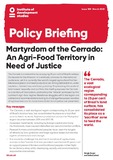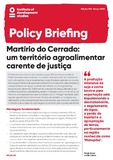Martyrdom of the Cerrado: An Agri-Food Territory in Need of Justice
Martírio do Cerrado: um território agroalimentar carente de justiça
| dc.contributor.author | Sauer, Sérgio | |
| dc.contributor.author | Cabral, Lídia | |
| dc.coverage.spatial | Brazil | en |
| dc.date.accessioned | 2022-03-24T09:44:43Z | |
| dc.date.available | 2022-03-24T09:44:43Z | |
| dc.date.issued | 2022-03-24 | |
| dc.identifier.citation | Sauer, S. and Cabral, L. (2022) 'Martyrdom of the Cerrado: An Agri-Food Territory in Need of Justice', IDS Policy Briefing 189, Brighton: Institute of Development Studies, DOI: 10.19088/IDS.2022.010 | en |
| dc.identifier.citation | ||
| dc.identifier.citation | Sauer, S. e Cabral, L. (2022) 'Martírio do Cerrado: um território agroalimentar carente de justiça', IDS Policy Briefing 190, Brighton: Institute of Development Studies, DOI: 10.19088/IDS.2022.011 | pt |
| dc.identifier.issn | 1479-974X | |
| dc.identifier.uri | https://opendocs.ids.ac.uk/opendocs/handle/20.500.12413/17245 | |
| dc.description.abstract | The Cerrado is a natural biome occupying 25 per cent of Brazil’s surface. Compared to the Amazon, it is relatively unknown to international audiences, yet it is currently the world’s largest agricultural frontier. Intensive soybean and beef production are driving deforestation, water depletion, habitat loss, and land grabbing. Emphasising the scale of land-based inequality and conflicts, this briefing exposes the Cerrado as a territory of martyrdom, contrasting the ‘miracle’ portrayed by the dominant agri-food regime. Resistance struggles within the region are outlined and recommendations looking to challenge the success narrative of agribusiness and to move towards territorial justice are presented. | en |
| dc.description.abstract | O Cerrado é um bioma natural que ocupa 25% das terras do Brasil. É relativamente desconhecido do público internacional, se comparado com a Amazônia, mas é atualmente a maior fronteira agrícola do mundo. A produção intensiva de soja e de carne bovina impulsiona o desmatamento, o esgotamento da água, a perda de habitat, e o land grabbing (apropriação de terras). Salientando a escala da desigualdade e dos conflitos fundiários, este Briefing revela o Cerrado como um território de martírio, uma perspectiva que contrasta com o “milagre” retratado pelo regime agroalimentar dominante. As lutas de resistência na região são delineadas e são apresentadas recomendações que procuram desafiar a narrativa de sucesso do agronegócio e avançar para a justiça territorial. | pt |
| dc.description.sponsorship | British Council Grant 2019-RLWK11-10177 | en |
| dc.description.sponsorship | Newton Fund | en |
| dc.description.sponsorship | Economic and Social Research Council (ID ES/R00658X/1) | en |
| dc.language.iso | en | en |
| dc.publisher | Institute of Development Studies | en |
| dc.relation.ispartofseries | IDS Policy Briefing;189 | |
| dc.relation.ispartofseries | IDS Policy Briefing;190 | |
| dc.rights | This is an Open Access briefing distributed under the terms of the Creative Commons Attribution 4.0 International licence (CC BY), which permits unrestricted use, distribution, and reproduction in any medium, provided the original authors and source are credited and any modifications or adaptations are indicated. | en |
| dc.rights.uri | http://creativecommons.org/licenses/by/4.0/ | en |
| dc.subject | Agriculture | en |
| dc.subject | Environment | en |
| dc.subject | Globalisation | en |
| dc.subject | Politics and Power | en |
| dc.subject | Rights | en |
| dc.subject | Rural Development | en |
| dc.title | Martyrdom of the Cerrado: An Agri-Food Territory in Need of Justice | en |
| dc.title | Martírio do Cerrado: um território agroalimentar carente de justiça | pt |
| dc.type | IDS Policy Briefing | en |
| dc.rights.holder | Institute of Development Studies | en |
| dc.identifier.team | Rural Futures | en |
| dc.identifier.doi | 10.19088/IDS.2022.010 | |
| dc.identifier.doi | 10.19088/IDS.2022.011 | |
| dcterms.dateAccepted | 2022-03-24 | |
| rioxxterms.funder | Default funder | en |
| rioxxterms.identifier.project | Default project | en |
| rioxxterms.version | VoR | en |
| rioxxterms.versionofrecord | 10.19088/IDS.2022.010 | en |
| rioxxterms.funder.project | 9ce4e4dc-26e9-4d78-96e9-15e4dcac0642 | en |
Files in this item
This item appears in the following Collection(s)
Except where otherwise noted, this item's license is described as This is an Open Access briefing distributed under the terms of the Creative Commons Attribution 4.0 International licence (CC BY), which permits unrestricted use, distribution, and reproduction in any medium, provided the original authors and source are credited and any modifications or adaptations are indicated.



